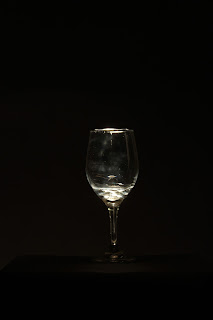Glass is hard to shoot for several reasons
- It has mirror qualities and it reflects almost anything in front of it creating distractions
- It is transparent and light just goes through it making it hard to define its shape
- It is very smooth and punishes up for every speck of dust
In dark field lighting, you use a dark background. If all you used was a dark background the glass object would have no shape. The way to overcome this is by highlighting the glass edges.
The edges are lit by light, with the light positioned behind the object and black card. either side of the glass you have 2 pieces of black card into a V shape. The light will travel from the back of the card through the sides of the v shape to illuminate the edges of the glass.
http://www.diyphotography.net/crossing-over-to-the-dark-field-has-never-been-easier/ 17.12.15
I done this technique in the studio the glasses we used were quite dirty I tried washing these in the toilet to the best i could but you could still see a lot of dust, prints and smears all over. I tried using the wine glass and a perfume bottle. The perfume bottle didn't look as effective as the wine glass as in I don't think I could illuminate to the best of what I could. As I couldn't get rid of the smears and no other glass objects to hand I tried using coloured gels on the lights. These are interesting and effective than just the white light shone from behind.
Light field/ Bright field
In bright field lighting we do the exact opposite from what we did in dark field.
The background is lit and the body of the glass pears to be white. The edges are defined by dark cards that create “negative light”.
Again, the background light is limited to the smallest area possible to reduce flare.
The image above was taken using the setup below. Two CFL snoots were used to create a contained white background, and black cards were used to define the edges of the glass.
Adding the same set up as above we created some interesting lighting set ups for photographing the lillies. You can apply this style of lighting not just to glass but to other objects as you can see from the images above it gives you great tonal ranges that gives the images added depth.


















No comments:
Post a Comment